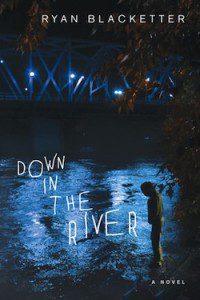
In his memoir The Child That Books Built, Francis Spufford once described the unmitigated power of a story’s “challenge” to its readers: “You are alone, in a dark wood. Now cope.” Ryan Blacketter’s debut novel, Down in the River, casts us deep into a haunting, crystalline forest of ice-lit trees, broken streetlamps, fog-shrouded waters, rime-coated leaves and snow-drifted lanes—a place where a kind of inner wilderness has crept back through the city, where the lights of passing trains, the reflections of windows and the “cry of night birds” appear intermittently like forms of meaningless chaos or secret signs. Here, the center hasn’t held. There is “no visible path into the trees,” as Blacketter writes—nor is there one that might lead his youthful, struggling characters back out of them again. Instead, there’s a sense of death and absence beneath a labyrinth of urban streets, mountain roads and tangled lives. To the denizens of this world, the line between desecration and salvation, criminality and morality, is no longer clear.
Wandering by a vacant department store in Eugene, Oregon, where he lives with his mother and brother, the teenage protagonist Lyle Rettew notes, “There was nothing but dust on display in the windows. The spotlight beam flashed again in the sky, then vanished and appeared, seeming to speed up with the approach of midnight. He was pointed toward the apartment, but he still had plenty of wildness in him to throw at the night.” That wildness, and what Lyle does with it, becomes the subject of the novel’s intricate plot. The small mountain town of his childhood now seems a distant, sealed-off world. As he travels through nocturnal cityscapes with a dead girl’s body in his backpack, he appears obsessed with the idea of rescuing people—and perhaps himself—from their own displacement.

Gradually, we learn that Lyle’s working-class family has been thrown out of their church after his twin sister’s suicide, that he has refused to take medication for his manic depression, and that he yearns for some new form of meaning, ritual and connection. Seeking solace in friendship, drugs, love, risk-taking and religion, he finds only brief moments of warmth that flare like votive candles and then are gone. His quest for a lost wholeness is mirrored in a leitmotif of shattered, twin-like images. His sister’s drowning creates an eerie repetition of his father’s death. The corpse he carries belongs to another character’s sister, lost in the deep snows of Mt. Hood. And by stealing the body from a mausoleum and trying to bury it in what seems, to him, its proper place, he hopes, perhaps, to give rest to the “shuddering ghosts” of both girls.
In a recent issue of Orion, Rebecca Solnit explains, “Sometimes you travel so that the process of becoming that is your inner life has an external correlative in your movement across space. You may not know how to save your soul, but you know how to put one foot in front of another. You may not know the way to stop being so furious you can hardly sleep, but you can buy a road map of the American West. And then you can put the need on like a knapsack and wear it along your journey, wear it out, shed it, find that it belongs to someone you no longer are. This is pilgrimage, which is not as pretty as it sounds. It’s not running away, though: it’s running toward.” The world of Down in the River shows the extent to which people like Lyle, who exist on the margins of American society, are finding that the escape and self-reinvention that the West once seemed to promise are now mirages at best—beguiling, atavistic fantasies that can ultimately lead to destruction. Lyle’s pilgrimage isn’t “pretty,” but the desperate earnestness of his actions—and the emotional honesty of the author’s writing—makes this novel a significant, engrossing and darkly sublime evocation of precarious, contemporary lives.
Even as Lyle runs toward trouble and danger, his youthful optimism, however delusory it might be, flickers in these pages, compelling the reader to journey deeper into night, in search of hope and redemption. “People did such things. Now he’d do them,” Lyle muses about his future plans, with a persistent wistfulness, as though he’s still trying to link his destiny to some kind of community, even if it’s only a community of the lost.
With his deft evocation of the darker places in modern landscapes and human minds, Blacketter has created a complex and elegantly structured edifice of memory and loss—a geography that feels profoundly apocalyptic and dystopian, and yet, at the same time, recognizably our own.




